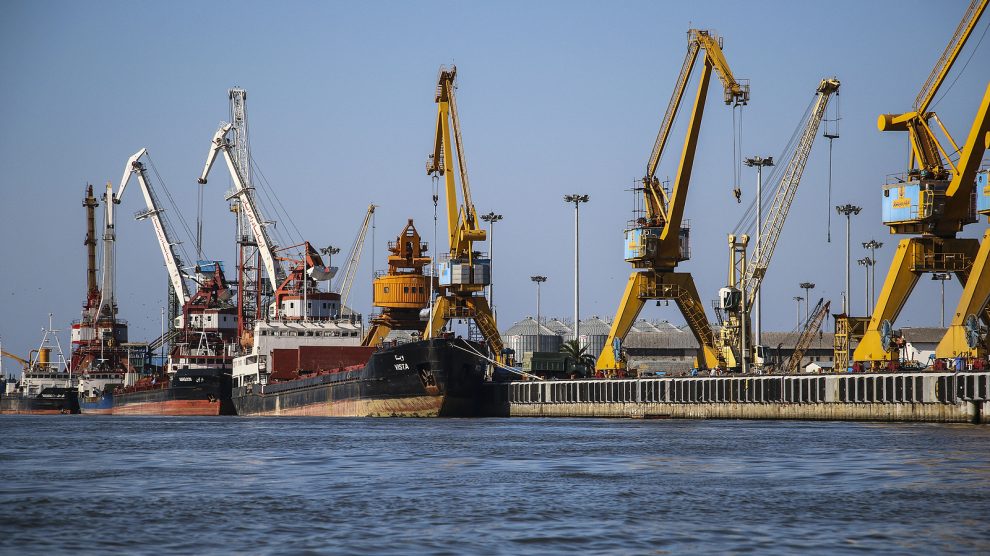The globalisation of supply chains gives countries stakes in the most unexpected of places. As Israel and Pakistan back Azerbaijan in the South Caucasus, their rivals Iran and India look to support Armenia.
On April 20, Armenia hosted Indian and Iranian officials in Yerevan for a first-ever trilateral summit to discuss trade issues—with a clear strategic context.
Iran’s free trade agreement with the Eurasian Economic Union (EEU) will come into effect by September, and Armenia is the only member of that ostensibly single market that borders Iran.
- The ‘Zangezur Corridor’ is a geo-economic revolution
- Explainer: Azerbaijan, Iran and the crisis in the South Caucasus
- Armenia and the Kremlin’s playbook: Myths about national minorities in Ukraine and Azerbaijan
The Persian Gulf–Black Sea International Transport and Transit Corridor runs from Iran through Armenia and Georgia to the European Union via the Black Sea. The International North-South Transport Corridor (INSTC) between Russia and India has three routes: a western route from the Caucasus to the Persian Gulf, a central route between Russian and Iranian ports on the Caspian Sea, and an eastern route from Central Asia to the Persian Gulf.
To circumvent its neighbouring rival Pakistan, India ships goods overseas to Iran’s Chabahar Port—from where they are shipped overland to Europe and elsewhere. The Rasht-Astara rail link, which would complete rail access from Chabahar to Russia by connecting existing Iranian rail to Azerbaijan, remains unfinished.
Iran and Azerbaijan’s relationship has rapidly deteriorated over Baku’s close ties to Tehran’s archnemesis, Israel, and the status of ethnic Azerbaijanis living in Iran. These tensions have delayed the railroad’s construction—although the Russian and Azerbaijani foreign ministers jointly announced in March that they would move ahead completing it.
In light of its deteriorated relations with Azerbaijan and the railroad’s construction delays, INSTC and Persian Gulf-Black Sea shipping routes through Armenia have become even more important to Iran as a means of bypassing its rival, Turkey, and Azerbaijan.
The Zangezur Corridor
Azerbaijan, however, has interests of its own. As the Armenian-Azerbaijani border remains closed, overland travel between the Azerbaijani exclave of Nakhchivan and the rest of Azerbaijan must cross into and then out of Iran. Baku holds that the terms of the agreement that ended the 2020 war with Armenia entitle it to an extra-territorial corridor through Armenia’s southern Syunik Province—along the Armenian-Iranian border—to connect it to Nakhchivan.
This so-called ‘Zangezur Corridor’ would open an uninterrupted Middle Corridor trade route between members of the Organisation of Turkic States (OTS) by connecting Turkey to Central Asia via Azerbaijan and the Caspian Sea but could block Iran’s access to Armenia.
While Azerbaijani President Ilham Aliyev has threatened to establish the Zangezur Corridor “by force”, Armenian Prime Minister Nikol Pashinyan has said he had “ruled out” an extra-territorial corridor, saying it was a “redline”.
In a show of support for Armenia, Iranian Foreign Minister Hossein Amir-Abdollahian visited Kapan in the Syunik Province in October to open a consulate there and said that any change to the nearby border was a “redline” Iran would take “all steps to resist”.
Using the INSTC is quicker and cheaper than shipping goods via the Suez Canal, so India has a vested interest in ensuring trade via the Iranian-Armenian border remains possible.

Equal, opposite reaction
Pakistan has aligned itself with Azerbaijan and participated in joint military drills. Pakistan does not recognise Armenia and is one of only a handful of countries to recognise the 1992 massacre of Azerbaijani civilians in Khojaly by Armenian forces as a ‘genocide’.
India is happy to support Armenia against Pakistan’s ally, and the two countries have their own shared history.
Armenian soldiers and merchants have travelled to India since at least the time of Alexander the Great, and India has had a sizable Armenian community since at least the 16th century—the first Armenian church in Agra was built in 1562.
A week before the trilateral summit in Yerevan, the Armenian envoy to India—Youri Babakhanian—referenced this shared history, saying, “We [India and Armenia] have very long historical ties. I call this civilisational partnership… Some day we will turn this into a strategic partnership and I think that day is close. We share common interests and we have no contradictions. This must be institutionalised in a long-term cooperation between the two countries.”
India appointed a military attaché to Armenia in 2021 and is emerging as an important supplier of arms.
While 94 per cent of Armenia’s arms imports between 2015 and 2019 were from Russia, it has not received any since the 2020 Karabakh War due to Azerbaijani pressure and the pressures of the war in Ukraine. Armenia is courting the West for support and is wary of purchasing arms from Iran, lest it offend the United States.
“Armenia felt abandoned by the West and Russia as the Trump administration’s half-hearted efforts to broker a ceasefire came late,” Babakhanian says. But neither the West nor Russia seem to have any issue with Armenia acquiring arms from India.
Armenia has been able to purchase hundreds of millions of US dollars of counter-battery radar, missiles, rockets, ammunitions, and howitzers from India, and it is now reportedly considering purchasing MRSAM medium-range anti-aircraft missile systems.
The radars were reportedly airlifted on a Russian Air Force cargo plane to Armenia via Iranian airspace.
Unlike many news and information platforms, Emerging Europe is free to read, and always will be. There is no paywall here. We are independent, not affiliated with nor representing any political party or business organisation. We want the very best for emerging Europe, nothing more, nothing less. Your support will help us continue to spread the word about this amazing region.
You can contribute here. Thank you.







Add Comment